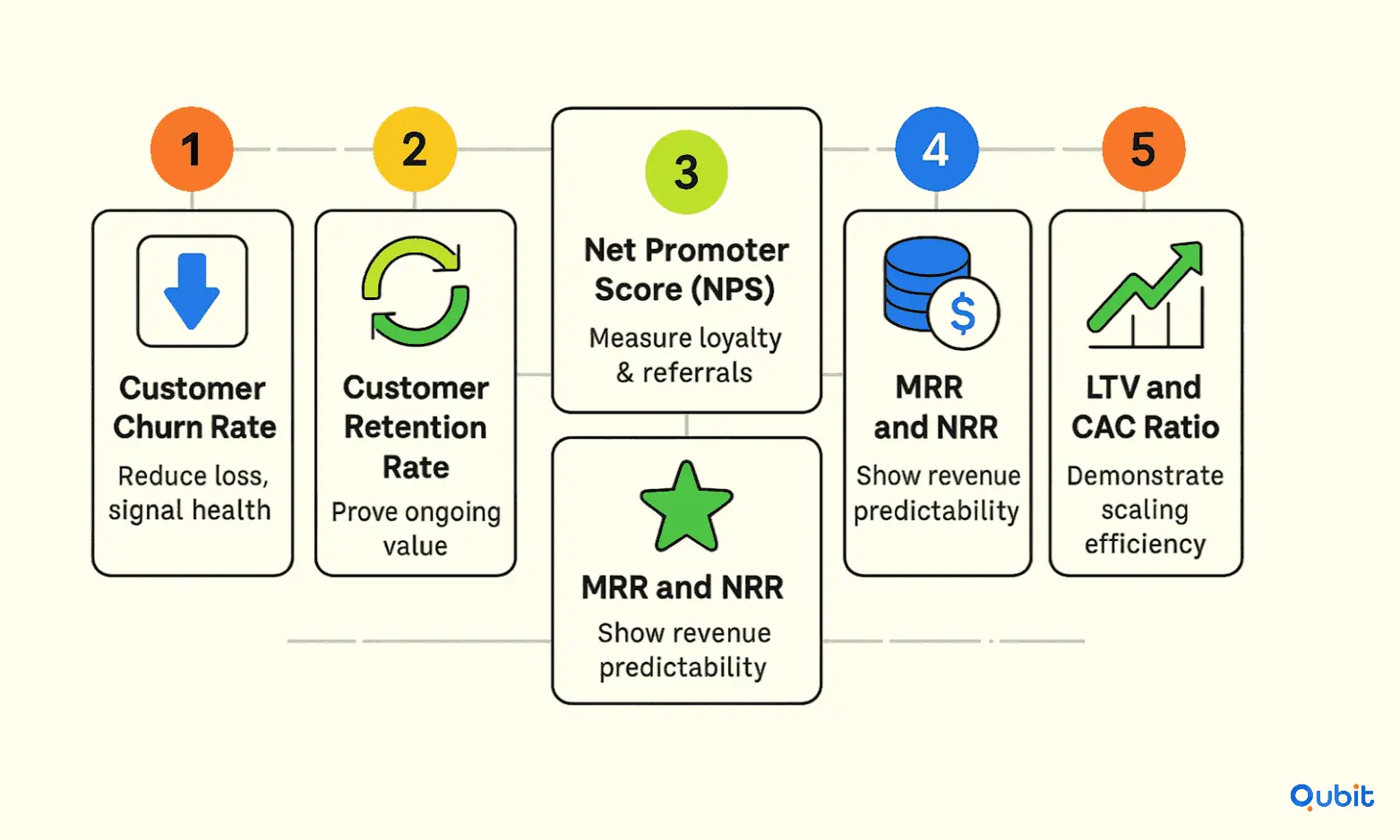Customer retention is more than just a performance indicator; it’s a window into the long-term viability of your software startup. Venture capitalists (VCs) often scrutinize retention metrics to gauge a company’s ability to sustain growth and profitability. By showcasing strong customer success metrics, startups can demonstrate their capacity to foster loyalty and drive recurring revenue.
An analysis of software startup fundraising strategies offers a comprehensive framework for evaluating diverse funding avenues, complementing the insights on retention metrics provided here.
This blog explores actionable strategies to optimize retention metrics, impress VCs, and secure funding. From understanding key metrics to implementing effective customer success practices, we’ll cover everything you need to know.
Let’s jump right in!
What is Customer Retention
Customer retention refers to the ability of a business to keep its customers over time, ensuring they continue to engage with its products or services. For software startups, strong customer retention metrics often signal product-market fit and provide a foundation for predictable revenue streams. When customers remain loyal, it demonstrates satisfaction with the product and reduces the need for constant acquisition efforts, which can be costly and time-consuming.
Effective onboarding plays a crucial role in retention, as it sets the tone for the customer’s experience. A seamless onboarding process ensures users understand the value of the product from the start, minimizing frustration and early churn. Beyond onboarding, continuous engagement strategies, such as personalized communication, timely updates, and proactive support—help maintain customer interest and satisfaction.
Why Customer Success Metrics Matter to VCs
VCs understand that acquiring a new customer can cost five times more than retaining an existing one. High retention and strong customer success not only signal product-market fit but also suggest efficient use of capital, lower churn, and a more predictable revenue stream, all critical for scaling and long-term profitability.
Early Warning Indicators and Product Stickiness
VCs appreciate startups that proactively track leading indicators of customer health and product engagement. These include:
- Declining product usage: A drop in daily or monthly active users (DAU/MAU) can signal waning interest.
- Support ticket volume and sentiment: Increased complaints or unresolved issues may precede churn.
- Feature adoption rates: Tracking which features customers use most helps identify what drives stickiness.
By monitoring these signals, your team can intervene early with targeted customer success efforts, reducing churn and improving retention. Demonstrating this proactive approach reassures investors that you manage risk effectively and prioritize long-term customer relationships.
The Metrics That Matter Most

1. Customer Churn Rate
This is the percentage of customers who stop using your product during a given period. A low churn rate signals high satisfaction and product stickiness—a key indicator for VCs that your business is built for sustainability.
Formula:
Churn Rate (%) = (Customers Lost During Period ÷ Total Customers at Start of Period) × 100
2. Customer Retention Rate
This metric shows the percentage of customers you retain over a set period. High retention rates are a green flag for VCs, demonstrating that your product delivers ongoing value and that your business can grow through expansion, not just acquisition.
3. Net Promoter Score (NPS)
NPS measures customer loyalty and satisfaction by asking how likely a customer is to recommend your product. A high NPS means your customers are not only happy but also likely to drive organic growth through referrals.
4. Monthly Recurring Revenue (MRR) and Net Revenue Retention (NRR)
MRR provides a snapshot of predictable revenue, while NRR shows your ability to grow revenue from existing customers (through upsells, expansions, etc.). VCs look for high and growing NRR as a sign of a “land and expand” strategy working in practice.
5. Customer Lifetime Value (LTV) and CAC-to-LTV Ratio
LTV estimates the total revenue a customer will generate during their relationship with your company. When paired with Customer Acquisition Cost (CAC), it tells VCs how efficiently you’re scaling. A healthy CAC-to-LTV ratio (typically 1:3 or better) is a strong sign of a scalable SaaS business
How to Present These Metrics to VCs
Benchmark Against Industry Standards:
If your churn is lower or your NRR is higher than industry averages, call it out. Contextualizing your performance makes your story more compelling
Show Trends, Not Just Snapshots:
Highlight how your retention, churn, and NPS have improved over time. Use graphs to show progress and the impact of customer success initiatives.
Segment Your Data:
Break down metrics by customer cohort, plan type, or industry. This demonstrates a deep understanding of your customer base and where your strengths lie.
Tie Metrics to Action:
Explain how specific changes (like onboarding improvements or support enhancements) led to measurable gains in retention or NPS. VCs want to see a feedback loop between action and result.
A review of global expansion software funding illustrates how scaling operations internationally can affect investor evaluation, integrating seamlessly with the retention strategy discussion. Expanding globally not only broadens the customer base but also provides insights into retention trends across diverse markets.
Customer Advocacy and Reference Strategy
Satisfied customers who become advocates are invaluable assets in fundraising and growth. VCs look for evidence that you have a structured process to cultivate customer references, testimonials, and case studies.
- Encourage happy customers to participate in reference calls and provide endorsements.
- Develop customer advisory boards to engage your most loyal users.
- Use advocacy programs to generate organic referrals and social proof.
Highlighting your customer advocacy strategy shows investors that your growth is sustainable and supported by genuine customer enthusiasm.
Using Customer Success Technology to Improve Retention Metrics
Customer success technology plays a crucial role in boosting retention and satisfaction metrics, making your startup even more appealing to VCs. Tools such as Customer Relationship Management (CRM) systems, automated onboarding platforms, and AI-driven support chatbots help deliver personalized, proactive engagement that anticipates customer needs and addresses issues before they escalate.
- Predictive Analytics: By examining usage patterns and customer behavior, predictive analytics can identify at-risk customers early, giving your team the opportunity to intervene and reduce churn.
- Automated Communication: Automated workflows ensure timely check-ins, renewal reminders, and personalized content delivery, helping to build stronger relationships without overwhelming your team.
- Customer Health Scores: These composite metrics combine indicators, such as product usage, support tickets, and NPS, to provide a real-time view of customer satisfaction and loyalty.
Adopting these technologies not only improves your key metrics but also shows investors that your company uses scalable, data-driven strategies to maintain and grow its customer base. This technological advantage can set your business apart in conversations with potential investors.
Customer Success as a Growth Engine
A robust customer success strategy doesn’t just reduce churn, it drives expansion. Satisfied customers are more likely to upgrade, renew, and refer others, fueling organic growth and reducing reliance on expensive acquisition channels. VCs recognize that companies with best-in-class retention and customer advocacy can achieve higher valuations and more sustainable growth.
Industry Benchmarks and Stage-Appropriate Metrics
Contextualizing your retention and success metrics against industry benchmarks helps investors evaluate your performance realistically. For example:
- Early-stage SaaS startups often have higher churn rates but should demonstrate improving trends.
- Mature companies typically aim for churn below 5% annually and NRR above 100%.
Tailoring which metrics you emphasize based on your funding stage (Seed, Series A, etc.) ensures your pitch resonates with investor expectations and highlights your readiness for the next growth phase.
Conclusion
Retention metrics are more than just numbers, they tell a compelling story about your startup's ability to engage and retain users. VCs are increasingly prioritizing customer success and retention metrics as leading indicators of a startup’s health and scalability. By tracking, improving, and clearly presenting these metrics, you not only impress investors but also build a stronger, more resilient business for the future
If you're ready to present your startup with a pitch deck that emphasizes retention metrics and other key performance indicators, we can help craft a winning presentation. Start here to create a pitch deck that captures your vision and drives results.
Key Takeaways:
- Retention metrics are critical for assessing startup health and investor appeal.
- Measuring customer retention alongside churn provides a comprehensive view of engagement.
- Revenue-based metrics like CLV and MRR churn reveal the financial impact of retention strategies.
- Leveraging advanced tools and data-driven approaches is key to sustainable growth.
Frequently asked Questions
What are the key customer retention metrics for startups?
Key metrics include customer retention rate, churn rate, revenue churn, and customer lifetime value. These metrics provide valuable insights into customer loyalty and the financial health of your startup.


 Back
Back



